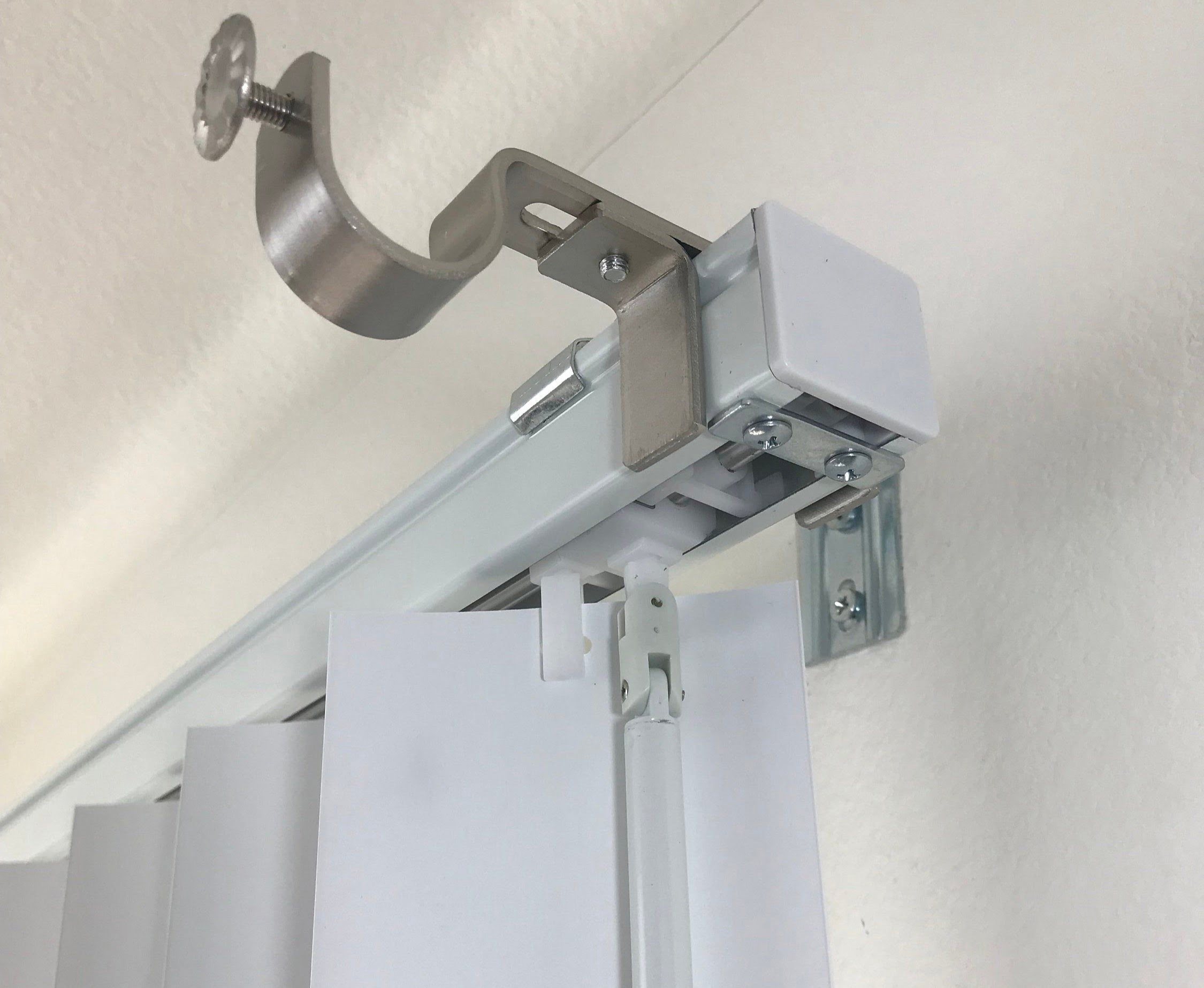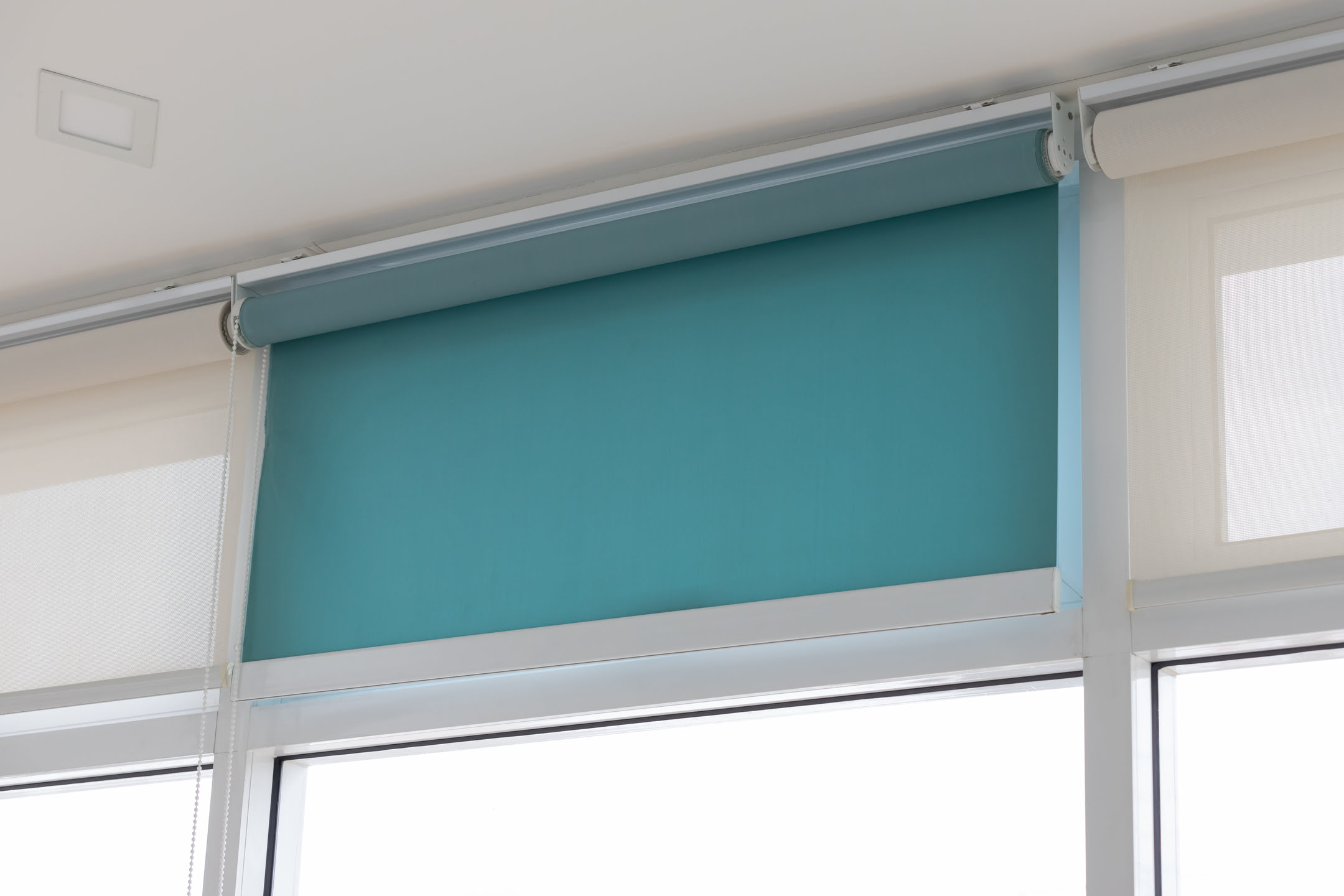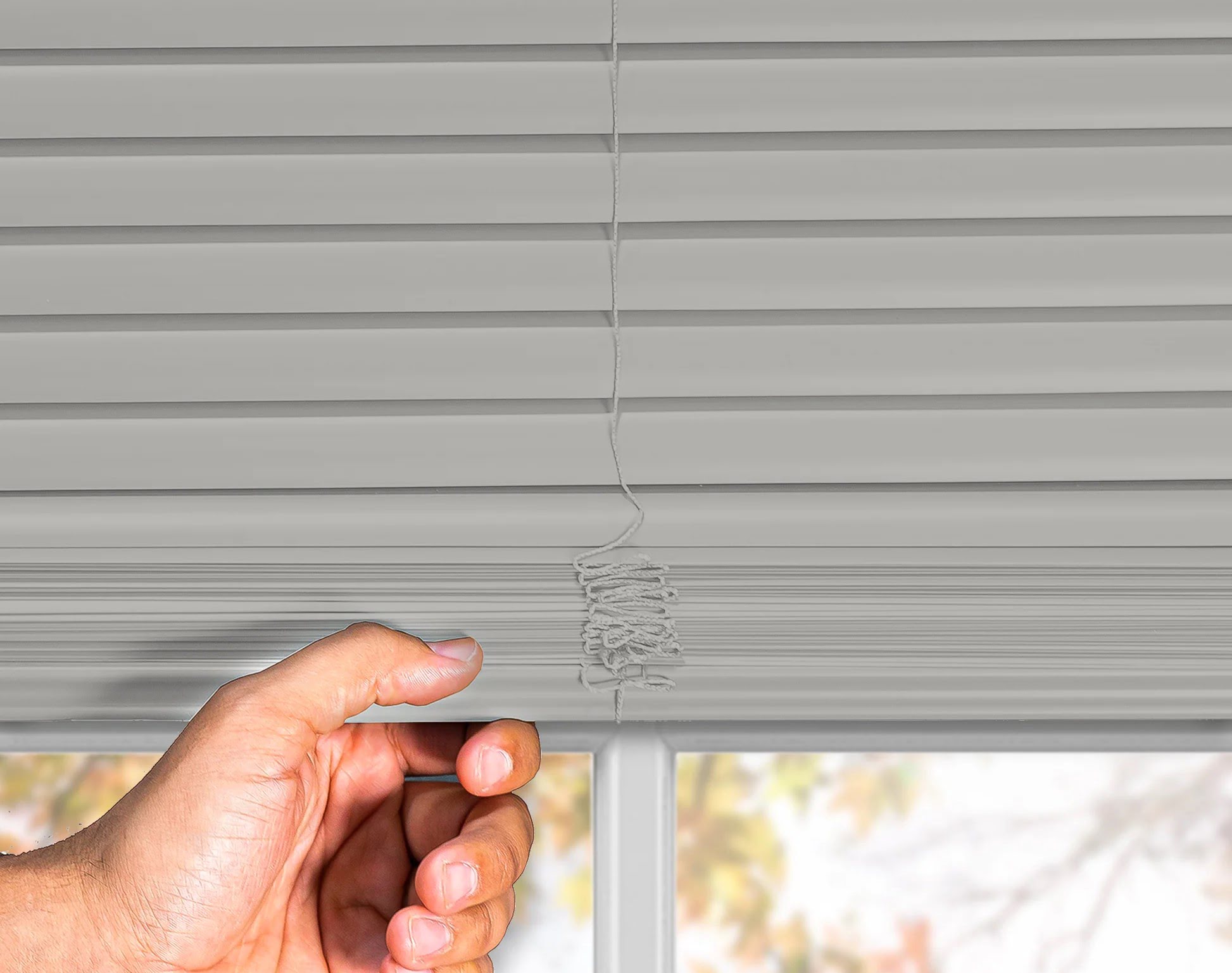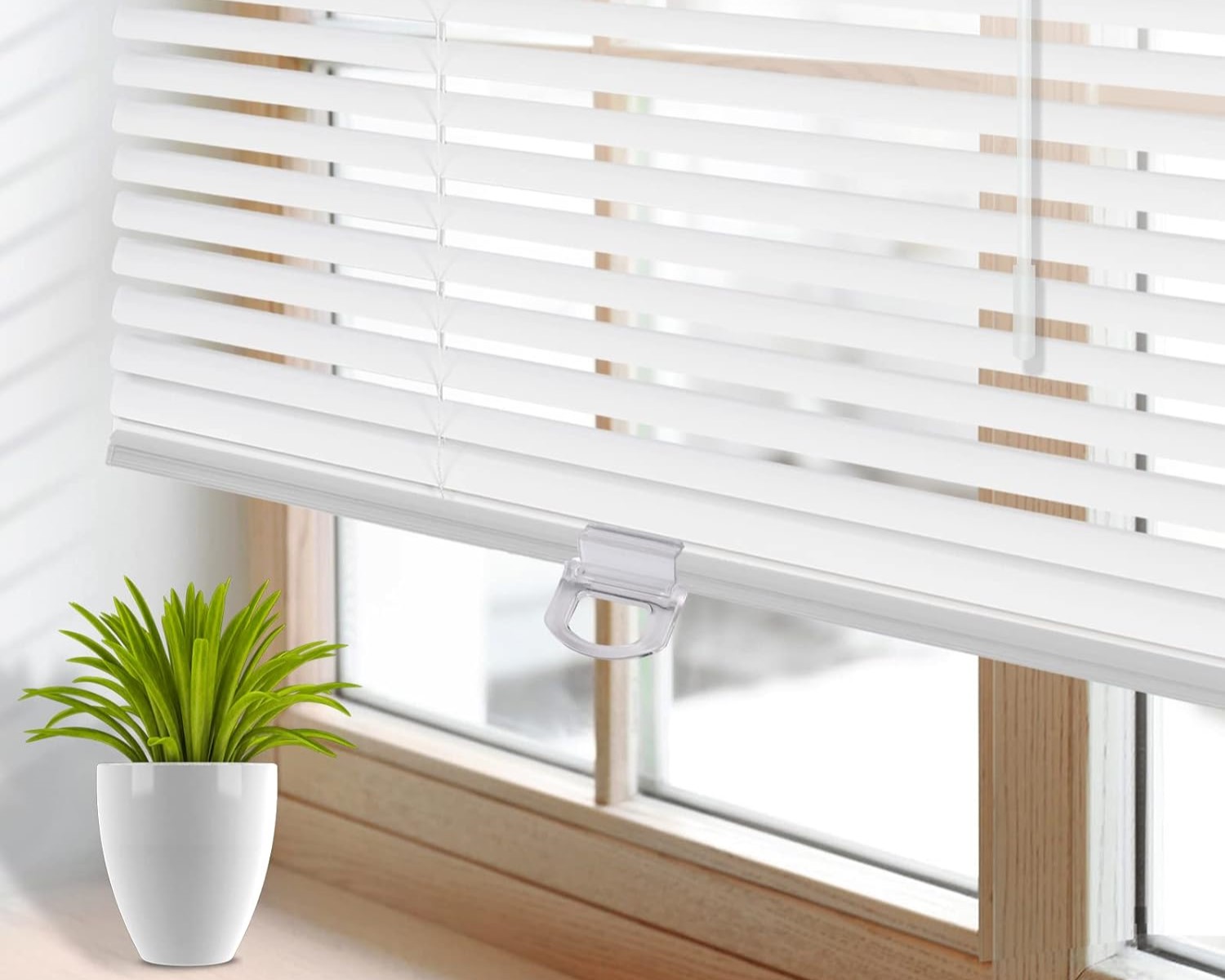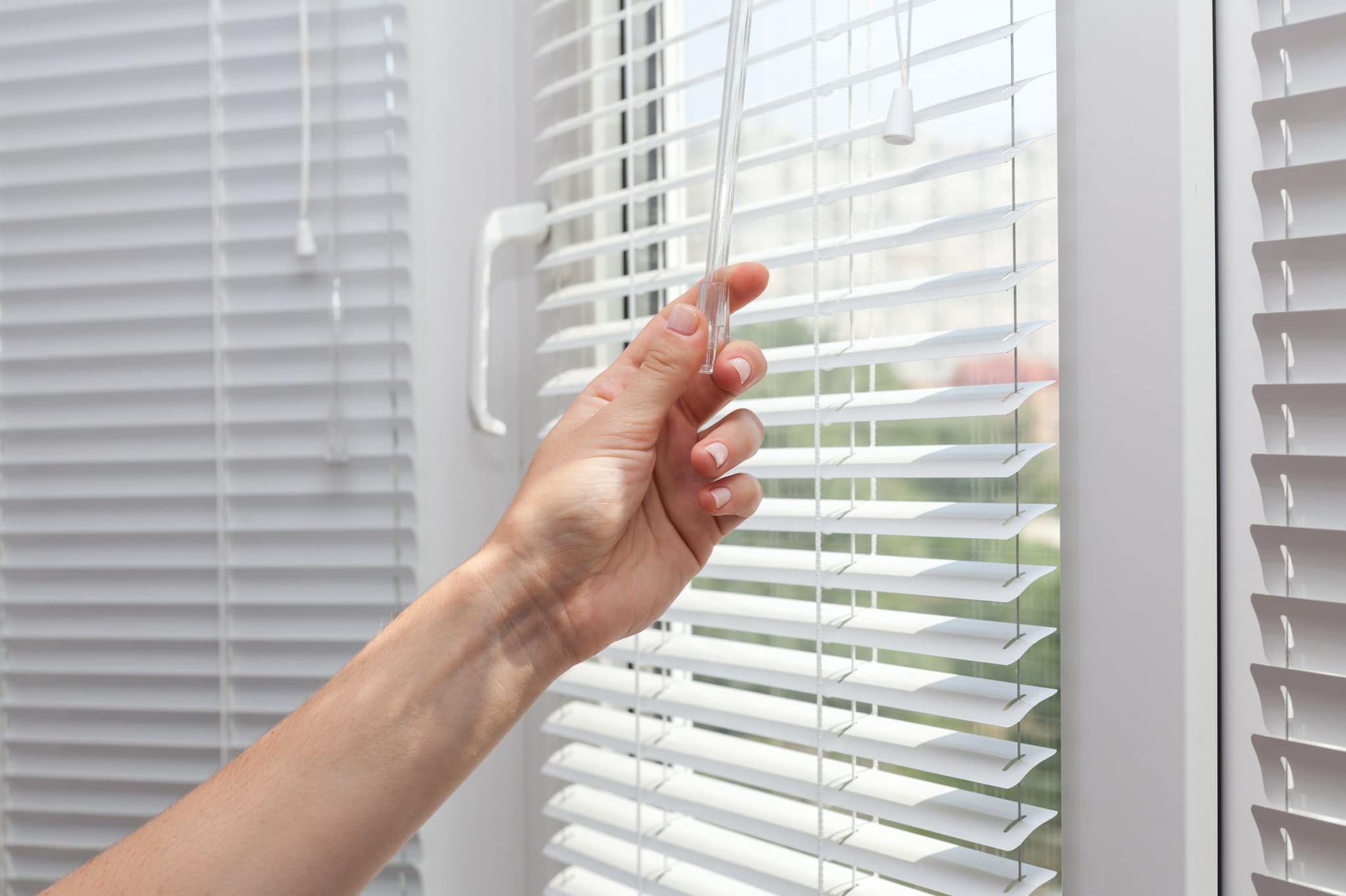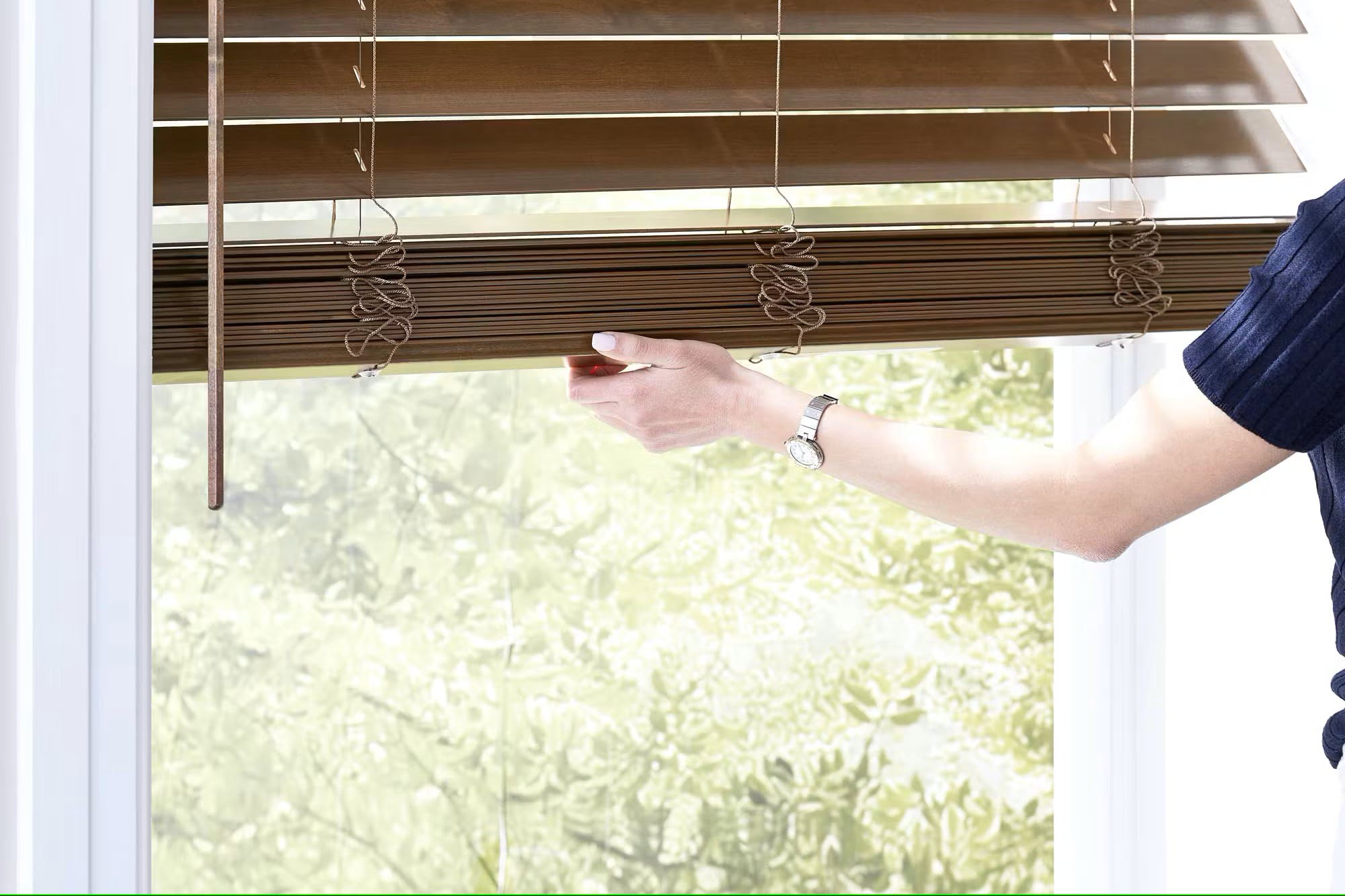

Articles
How To Fix Window Blinds That Won’t Go Down
Modified: March 1, 2024
Learn effective methods to fix window blinds that won't go down with helpful articles and practical tips.
(Many of the links in this article redirect to a specific reviewed product. Your purchase of these products through affiliate links helps to generate commission for Storables.com, at no extra cost. Learn more)
Introduction
Window blinds are a popular choice for homeowners who want to control the amount of light entering their homes and maintain privacy. They come in various styles and materials, including horizontal blinds and vertical blinds. Unfortunately, one common issue that homeowners face is window blinds that won’t go down. This can be frustrating, especially when you’re trying to block out the harsh sunlight or simply adjust the blinds to your desired position.
There are several reasons why window blinds may become stuck in the up position. Understanding these causes can help you troubleshoot and fix this issue effectively. In this article, we will explore the common causes of window blinds getting stuck, and provide you with step-by-step instructions on how to fix window blinds that won’t go down.
Key Takeaways:
- Don’t let stuck window blinds darken your day. From untangling lift cords to replacing mechanisms, this DIY guide helps you shed light on fixing the issue and enjoying well-functioning blinds once again.
- When window blinds won’t budge, troubleshooting is key. Whether it’s realigning lift cords or seeking professional help, this article equips you with the know-how to tackle the problem head-on and restore functionality to your blinds.
Common Causes of Window Blinds Stuck in the Up Position
Before we delve into the solutions, let’s take a look at the common causes of window blinds getting stuck in the up position. By identifying the root cause, you’ll be better equipped to address the issue.
1. Lift Cords Misaligned: The lift cords in window blinds are responsible for raising and lowering the blinds. If the lift cords become tangled or misaligned, it can cause the blinds to get stuck in the up position.
2. Tilt Mechanism Jammed: The tilt mechanism allows you to adjust the angle of the blinds’ slats. If the tilt mechanism becomes jammed or obstructed, it can prevent the blinds from lowering or tilting properly.
3. Cord Lock Malfunction: The cord lock mechanism is responsible for securing the blinds in place once they are lowered. If the cord lock malfunctions or becomes damaged, it can prevent the blinds from staying in the down position.
4. Bottom Rail Issues: The bottom rail of the blinds helps to provide stability and support. If the bottom rail becomes damaged or warped, it can affect the smooth operation of the blinds.
Now that we have a better understanding of the potential causes, let’s gather the necessary tools and materials to fix the problem.
Tools and Materials Required
To fix window blinds that won’t go down, you’ll need the following tools and materials:
– Screwdriver (flathead or Phillips, depending on the type of screws used in your blinds)
– Pliers
– Replacement lift cords
– Replacement cord lock mechanism (if necessary)
– Replacement tilt mechanism (if necessary)
– Lubricant (such as silicone spray or powdered graphite)
– Replacement bottom rail (if necessary)
Now that you’re prepared, let’s move on to the step-by-step guide on how to fix your window blinds.
Key Takeaways:
- Don’t let stuck window blinds darken your day. From untangling lift cords to replacing mechanisms, this DIY guide helps you shed light on fixing the issue and enjoying well-functioning blinds once again.
- When window blinds won’t budge, troubleshooting is key. Whether it’s realigning lift cords or seeking professional help, this article equips you with the know-how to tackle the problem head-on and restore functionality to your blinds.
Common Causes of Window Blinds Stuck in the Up Position
Before we delve into the solutions, let’s take a look at the common causes of window blinds getting stuck in the up position. By identifying the root cause, you’ll be better equipped to address the issue.
1. Lift Cords Misaligned: The lift cords in window blinds are responsible for raising and lowering the blinds. Over time, these cords can become tangled or misaligned, causing the blinds to get stuck. This can happen if the cords get twisted or if they come off the pulleys that control their movement. If the lift cords are misaligned, the blinds won’t be able to move up or down smoothly.
2. Tilt Mechanism Jammed: The tilt mechanism allows you to adjust the angle of the blinds’ slats, allowing for greater control over privacy and light. If the tilt mechanism becomes jammed or obstructed, it can prevent the blinds from lowering or tilting properly. This can happen if dirt, dust, or debris accumulates in the mechanism or if any of the components become damaged.
3. Cord Lock Malfunction: The cord lock mechanism is responsible for securing the blinds in place once they are lowered. If the cord lock malfunctions or becomes damaged, it can prevent the blinds from staying in the down position. This can happen if the cord lock gets stuck, the spring inside the mechanism wears out, or if any of the components become broken or bent.
4. Bottom Rail Issues: The bottom rail of the blinds helps to provide stability and support. If the bottom rail becomes damaged or warped, it can affect the smooth operation of the blinds. This can cause the blinds to get stuck in the up position or make it difficult for them to lower properly. Bottom rail issues can occur over time due to wear and tear, excessive force, or exposure to moisture.
It’s important to note that these causes can often be interrelated. For example, if the lift cords are misaligned, it can put strain on the tilt mechanism, which in turn can affect the cord lock mechanism and the overall operation of the blinds. Therefore, it’s essential to thoroughly inspect and address each potential cause to ensure effective troubleshooting and repair.
Now that we have a better understanding of the potential causes, let’s gather the necessary tools and materials to fix the problem.
Tools and Materials Required
To fix window blinds that won’t go down, you’ll need the following tools and materials:
1. Screwdriver: Having a screwdriver on hand is essential for most blind repair tasks. Depending on the type of blinds you have, you may need a flathead or Phillips screwdriver to remove screws and access various components.
2. Pliers: Pliers are useful for gripping and manipulating small parts, such as cords, springs, or clips. They can help you reposition or untangle lift cords or adjust other mechanisms.
3. Replacement Lift Cords: If the lift cords in your blinds are damaged or severely tangled, you may need to replace them. Measure the length of the existing lift cords to ensure you purchase the correct size replacements.
4. Replacement Cord Lock Mechanism: If your blinds’ cord lock mechanism is broken, worn out, or no longer functioning properly, you may need to replace it. Make sure you get a cord lock that matches the style and size of your existing blinds.
5. Replacement Tilt Mechanism: If the tilt mechanism of your blinds is jammed or damaged beyond repair, you may need to replace it. Check the specific requirements of your blinds and purchase a new tilt mechanism accordingly.
6. Lubricant: A silicone spray or powdered graphite lubricant can help resolve issues with jammed or stiff mechanisms. Apply a small amount of lubricant to the affected areas to improve the movement of the blinds.
7. Replacement Bottom Rail: If the bottom rail of your blinds is cracked, warped, or compromised in any way, it may be necessary to replace it. Measure the length of the existing bottom rail before purchasing a replacement.
It’s important to have these tools and materials readily available before starting the repair process. This ensures that you can proceed smoothly and efficiently without any unnecessary delays. With everything in hand, we can now move on to the step-by-step guide on how to fix your window blinds.
Read more: How Do You Make Blinds Go Down
Step-by-Step Guide to Fix Window Blinds That Won’t Go Down
Now that you have gathered the necessary tools and materials, it’s time to get started on fixing your window blinds. Follow these step-by-step instructions to troubleshoot and resolve the issue:
1. Inspect the Lift Cords: Begin by checking the lift cords for any tangles, knots, or misalignments. Gently untangle any knots and ensure that the cords are properly threaded through the pulleys.
2. Adjust the Lift Cords: If the lift cords are misaligned, you may need to adjust their positioning. Locate the cord lock mechanism and remove the end cap to access the lift cords. Use pliers if necessary to adjust the positioning of the cords on the lock mechanism to ensure they are aligned.
3. Examine the Tilt Mechanism: Check the tilt mechanism to see if it is jammed or obstructed. If you notice any debris or dirt inside the mechanism, use a small brush or compressed air to clean it out. If the tilt mechanism is damaged or worn out, consider replacing it with a new one.
4. Lubricate the Mechanisms: Apply a small amount of silicone spray or powdered graphite lubricant to the lift cords, pulleys, and tilt mechanism. This lubrication will help improve the movement of the blinds and prevent any sticking or jamming.
5. Inspect and Repair the Cord Lock Mechanism: If the lift cords still do not hold in the down position, the cord lock mechanism may be the culprit. Carefully remove the end caps of the headrail to access the cord lock. Inspect the mechanism for any damage or wear and consider replacing it if necessary.
6. Check the Bottom Rail: Examine the bottom rail of the blinds for any cracks, warping, or damage. If the bottom rail is compromised, it can impede the smooth operation of the blinds. Depending on the extent of the damage, you may either need to repair or replace the bottom rail.
7. Test the Blinds: After making the necessary adjustments and repairs, test the blinds to ensure they are now functioning properly. Gently pull the lift cords and check if the blinds lower smoothly and remain in the desired position. Additionally, test the tilt mechanism to ensure it adjusts the slats correctly.
By following these step-by-step instructions, you should be able to fix your window blinds that won’t go down. However, if you’re uncomfortable performing these tasks yourself or if the issue persists, it may be best to seek professional help. Now you can enjoy the convenience and functionality of properly working window blinds in your home once again.
If your window blinds won’t go down, try checking the lift cords for any tangles or knots. Untangle them and ensure they are properly aligned to allow the blinds to lower smoothly.
Method 1: Checking and Adjusting the Lift Cords
One of the common causes of window blinds getting stuck in the up position is misaligned lift cords. Over time, these cords can become tangled or twisted, preventing the blinds from lowering. Follow these steps to check and adjust the lift cords:
1. Inspect the Lift Cords: Begin by examining the lift cords to check for any tangles, knots, or misalignments. Locate the end of the lift cords at the bottom of the blinds and carefully unwind any knots or tangles.
2. Reposition the Lift Cords: If the lift cords are misaligned, their positioning may need to be adjusted. Find the cord lock mechanism, usually located at the headrail of the blinds. Remove any end caps or covers that provide access to the cord lock.
3. Adjust the Lift Cords on the Cord Lock Mechanism: Use a pair of pliers to carefully grasp and reposition the lift cords on the cord lock mechanism. Ensure that the cords are properly threaded through the designated slots or hooks on the mechanism. This will help align the cords correctly and allow for smooth operation.
4. Test the Blinds: After adjusting the lift cords, test the blinds to see if they lower properly. Gently pull down on the lift cords to lower the blinds, then release the cords to check if they hold the blinds in place. Repeat this process a few times to ensure that the lift cords are functioning as desired.
5. Make Further Adjustments if Necessary: If the blinds still don’t lower smoothly or if the lift cords don’t hold properly, repeat the steps above to readjust the lift cords. It may take a few attempts to find the correct alignment for the lift cords on the cord lock mechanism.
Remember to handle the lift cords with care to avoid causing any damage or further tangles. Additionally, make sure to test the blinds at each step to evaluate if the adjustment has resolved the issue. If you find that this method does not fix the problem, proceed to the next method.
It’s important to note that while adjusting the lift cords can often resolve the issue, it’s crucial to address any underlying causes, such as tangled cords or damaged components, to prevent future problems. By properly maintaining and periodically checking the lift cords, you can ensure smooth and trouble-free operation of your window blinds.
Method 2: Inspecting and Realigning the Tilt Mechanism
If your window blinds won’t go down, another potential cause to investigate is a jammed or misaligned tilt mechanism. The tilt mechanism is responsible for adjusting the angle of the blinds’ slats. Follow these steps to inspect and realign the tilt mechanism:
1. Access the Tilt Mechanism: Depending on the type of blinds you have, the tilt mechanism can be located either on the headrail or the side of the blinds. Use a screwdriver to remove any screws or clips that hold the mechanism in place, allowing you to access it.
2. Examine the Tilt Mechanism: Carefully inspect the tilt mechanism for any signs of obstruction, damage, or misalignment. Look for dirt, dust, or debris that may be causing the mechanism to jam. Also, check if any of the components, such as gears or shafts, are broken or worn out.
3. Clean the Tilt Mechanism: If you notice any debris or dirt inside the tilt mechanism, use a small brush or compressed air to gently clean it. Removing any dirt or debris can help eliminate potential sources of obstruction and improve the movement of the mechanism.
4. Realign the Tilt Mechanism: If the tilt mechanism appears misaligned, carefully adjust the components to realign them. This may involve repositioning gears, aligning shafts, or ensuring that the tilt rod is properly inserted and connected. Use a screwdriver or pliers, if necessary, to make the necessary adjustments.
5. Test the Blinds: After realigning the tilt mechanism, test the blinds to see if they lower and tilt properly. Engage the tilt mechanism and observe if the slats adjust smoothly. If the blinds still won’t go down or the slats don’t tilt as expected, recheck the alignment and make further adjustments if needed.
6. Lubricate the Tilt Mechanism: Once the tilt mechanism is properly aligned, consider applying a small amount of lubricant to enhance its performance. Use a silicone spray or powdered graphite lubricant and apply it sparingly to the movable parts of the mechanism. This will help improve the smoothness of the tilt mechanism.
7. Secure the Tilt Mechanism: After testing and ensuring that the tilt mechanism is functioning properly, securely fasten it back into place with screws or clips. Make sure it is firmly attached to the blinds’ headrail or side.
If the inspection and realignment of the tilt mechanism have resolved the issue, your window blinds should now be able to go down and the slats should tilt as desired. However, if the problem persists, move on to the next method to explore additional solutions.
Method 3: Replacing the Cord Lock Mechanism
Sometimes, the cord lock mechanism in your window blinds can malfunction or become damaged, preventing the blinds from staying in the down position. If you’ve tried adjusting the lift cords and inspecting the tilt mechanism without success, it may be necessary to replace the cord lock mechanism. Follow these steps to replace the cord lock:
1. Measure and Purchase a Replacement Cord Lock Mechanism: Begin by measuring the dimensions of your existing cord lock mechanism. Take note of the shape and size to ensure that you purchase a suitable replacement. You can find cord lock mechanisms at your local home improvement store or online retailers.
2. Remove the Old Cord Lock Mechanism: Locate the cord lock mechanism, which is typically positioned at the headrail of the blinds. Depending on the type of blinds you have, it may be secured with screws or clips. Use a screwdriver to remove any screws or gently detach any clips that hold the cord lock mechanism in place.
3. Detach the Lift Cords: Once the cord lock mechanism is released, detach the lift cords from the old mechanism. Take note of their original placement to ensure proper reattachment later.
4. Install the New Cord Lock Mechanism: Position the new cord lock mechanism in the same location where the old one was removed. Align it properly and secure it with screws or clips, as per the manufacturer’s instructions. Make sure it is tightly attached to the blinds’ headrail to ensure stability.
5. Reattach the Lift Cords: Thread the lift cords through the designated slots or hooks on the new cord lock mechanism, following the original configuration. Make sure the lift cords are properly aligned and not tangled or twisted.
6. Test the Blinds: After replacing the cord lock mechanism and reattaching the lift cords, test the blinds to see if they lower and stay in the down position. Gently pull down on the lift cords to lower the blinds and release them to check if the new cord lock securely holds them in place.
If the new cord lock mechanism successfully holds the blinds in the down position, you have successfully replaced the malfunctioning or damaged component. However, if the issue persists or you encounter difficulties during the replacement process, it may be beneficial to seek professional assistance or consult a blinds repair specialist. On the other hand, if replacing the cord lock mechanism did not resolve the issue, continue to the next method to explore additional solutions.
Read more: How Do You Fix Pull Down Blinds
Method 4: Repairing or Replacing the Bottom Rail
If your window blinds won’t go down, another potential culprit could be a damaged or warped bottom rail. The bottom rail provides stability and support to the blinds, and if compromised, it can affect the smooth operation of the blinds. Here’s how you can repair or replace the bottom rail:
1. Assess the Condition of the Bottom Rail: Begin by examining the bottom rail of your blinds. Look for any cracks, warping, or damage. If the bottom rail appears to be in poor condition, it may need repair or replacement.
2. Repairing Small Cracks: For minor cracks in the bottom rail, you can attempt to repair them. Clean the area around the cracks to remove any dirt or debris. Apply a small amount of super glue or epoxy adhesive to seal the cracks, ensuring that the adhesive is evenly distributed. Allow the adhesive to fully dry as per the manufacturer’s instructions.
3. Replacing the Bottom Rail: If the damage to the bottom rail is extensive or if you are unable to repair it effectively, it may be necessary to replace the bottom rail. Measure the length of the existing bottom rail to ensure that you purchase a replacement of the correct size. You can find replacement bottom rails at home improvement stores or through blinds manufacturers.
4. Removing the Old Bottom Rail: Detach the old bottom rail from the blinds by carefully removing any screws or clips that hold it in place. Make sure to keep track of the placement of lift cords or any other components that may be connected to the bottom rail.
5. Installing the New Bottom Rail: Position the new bottom rail in place, aligning it properly with the blinds. Secure it using screws or clips, as per the manufacturer’s instructions. Double-check that it is securely attached to ensure stability and proper functionality.
6. Testing the Blinds: After repairing or replacing the bottom rail, test the blinds to see if they go down smoothly. Gently pull down on the lift cords and observe if the blinds lower and stay in the desired position. Ensure that the new bottom rail provides stability and support for the blinds.
If repairing or replacing the bottom rail has resolved the issue, your blinds should now be able to go down properly. However, if the problem persists, it is advisable to consult a blinds repair specialist for further assistance or consider seeking professional help to ensure an effective and long-lasting solution.
Method 5: Seeking Professional Help
If you’ve tried the previous methods to fix your window blinds that won’t go down and the issue persists, or if you’re uncomfortable attempting further repairs on your own, it may be time to seek professional help. Here are a few reasons why seeking professional assistance can be beneficial:
1. Expertise and Experience: Professional blinds repair technicians have the expertise and experience to diagnose and address complex issues with window blinds. They are familiar with various types of blinds and their mechanisms, allowing them to quickly identify the root cause of the problem and provide appropriate solutions.
2. Specialized Tools and Equipment: Professionals have access to specialized tools and equipment that may not be readily available to homeowners. These tools enable them to perform repairs and replacements in a precise and efficient manner. By utilizing professional-grade equipment, they can ensure the best possible outcome for your window blinds.
3. Save Time and Effort: Hiring a professional to fix your window blinds saves you valuable time and effort. Instead of spending hours troubleshooting and performing repairs yourself, a professional can efficiently handle the task, allowing you to focus on other priorities.
4. Quality Assurance: Professional blinds repair technicians strive to deliver high-quality workmanship. They ensure that repairs are done correctly and use quality replacement parts when needed. This helps to prolong the lifespan of your blinds and minimize the likelihood of future issues.
5. Safety Concerns: In certain situations, attempting DIY repairs on window blinds can pose safety risks. Professionals are knowledgeable about safety protocols and take necessary precautions to avoid accidents or injuries during the repair process.
6. Warranty Coverage: If your window blinds are still under warranty, attempting DIY repairs may void the warranty. By seeking professional help, you can ensure that any necessary repairs or replacements are done in accordance with the warranty terms, preserving your coverage.
When seeking professional help, it’s important to choose a reputable blinds repair company. Research and read reviews to find a reliable service provider who specializes in window blinds repairs. Obtain multiple quotes and compare services and pricing before making a decision.
Remember, seeking professional help doesn’t necessarily mean that you’ve exhausted all your options or that the problem with your window blinds is irreparable. Sometimes, complex issues require the skills and expertise of professionals to ensure a successful resolution.
Conclusion
Dealing with window blinds that won’t go down can be a frustrating experience for homeowners. However, by understanding the common causes of this issue and following the appropriate troubleshooting methods, you can resolve the problem and restore the functionality of your blinds.
In this article, we discussed the common causes of window blinds stuck in the up position, including misaligned lift cords, jammed tilt mechanisms, malfunctioning cord lock mechanisms, and damaged bottom rails. We provided step-by-step instructions for various methods to fix these issues, including checking and adjusting lift cords, inspecting and realigning the tilt mechanism, replacing the cord lock mechanism, and repairing or replacing the bottom rail.
It’s important to approach these troubleshooting methods systematically, starting with the least complex solutions and progressing to more involved ones. By following these methods, homeowners can save time and effort in resolving the issue themselves.
However, it’s worth mentioning that some situations may require professional assistance. Seeking the help of a blinds repair technician can ensure that complex issues are addressed correctly and efficiently, while also providing expert guidance and access to specialized tools and equipment. Additionally, professionals can work within warranty guidelines if applicable, helping to preserve warranty coverage.
Remember, as a homeowner, maintenance is key to preventing future issues with your window blinds. Regularly inspecting and cleaning the mechanisms, avoiding excessive force, and addressing any signs of wear or damage promptly can help prolong the lifespan of your blinds and ensure their smooth operation.
In conclusion, addressing window blinds that won’t go down doesn’t have to be a daunting task. By applying the knowledge and methods outlined in this article, homeowners can tackle this issue effectively, either on their own or with the help of professionals. With properly functioning window blinds, you can enjoy enhanced privacy, control over light levels, and a more comfortable living environment in your home.
Frequently Asked Questions about How To Fix Window Blinds That Won't Go Down
Was this page helpful?
At Storables.com, we guarantee accurate and reliable information. Our content, validated by Expert Board Contributors, is crafted following stringent Editorial Policies. We're committed to providing you with well-researched, expert-backed insights for all your informational needs.


